American Show Line German Shepherd – Temperament and Care
For many people, German Shepherd dogs are all one big whole. For those in the know, however (and now that’s you), there are two key differences.
Some dogs come from what we call ‘working lines, and others are ‘show line’ German Shepherds. Today we dive into the intricacies of an American Show Line German Shepherd, what makes them so special, and how to decide if this is the right type of German Shepherd for your family.
What Is an American Show Line German Shepherd?
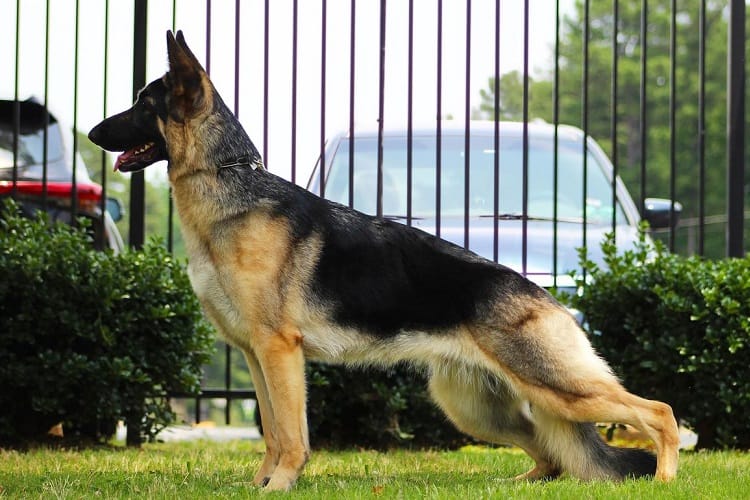
The American Show Line German Shepherd is a specific family in the broader German Shepherd net.
All GSD-type dogs originate from the dog Horand von Grafath, who Captain Max von Stephanitz owned. He helped standardize and found the breed.
Over time, as some owners wanted to focus more on aesthetics and temperament than the working drive, we saw the show line develop.
This leaves us with a calmer and brighter-coated Shepherd with a noted angularity to their frame. Show Line Shepherds aren’t rare by any means and are immensely popular due to their more amiable natures. They can successfully be both working dogs and beloved pets.
As with all popular dog breeds, there have been issues with backyard breeders, who care nothing for the health and well-being of the dog as long as they can make a buck. That’s not unique to American Show Line German Shepherds, but you must always consider it when buying or rescuing a dog.
This deplorable way of breeding can leave dogs of any type more prone to unpredictable tempers, bad genes, and poor health.
If you have your heart set on an American Show Line German Shepherd, it may be worth looking at purchasing from a reputable breeder, of which you will find many.
If you take a Shepherd from a rescue, spend some time chatting with the shelter about the individual dog’s temper, health, and what the workers have observed, so you have the best idea possible about the dog you’re taking on.
These dogs are Shepherd-family stars of the show ring, but they also make excellent family pets with a loving and loyal nature. It’s best thought of as a breed variant rather than a separate Shepherd breed.
Short History of the American Show Line German Shepherd
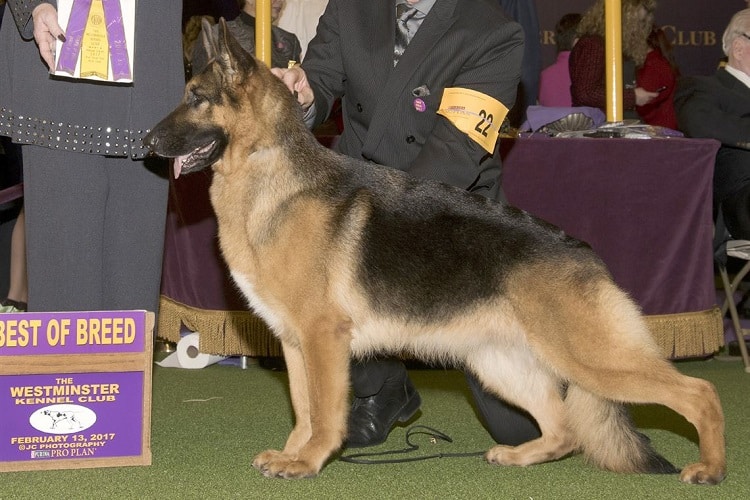
Did you know that the German Shepherd is one of the most recognizable dog breeds in the world today? In the U.S, it’s also the second most popular American Kennel Club-registered dog breed.
It has long origins in history, too. Originating from (you guessed it) Germany in 1899, it was bred to help shepherds keep their sheep safe and to herd them.
You may still see German Shepherds referred to as ‘Alsatians’. This is a nod to the German-French border area, Alsace-Lorraine.
They acquired the name in the World Wars to distance the breed from its country of origin, but breeders campaigned in 1977 to have it switched back to the original and, more accurate, name.
How Do They Differ From Working Line Gsds?
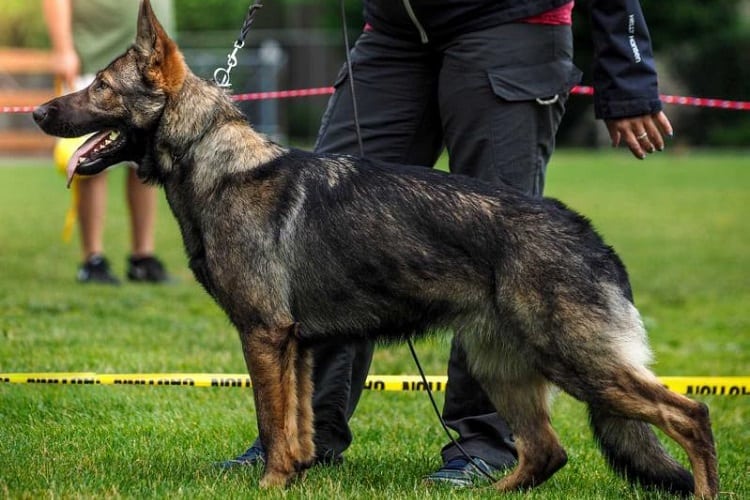
So how did we arrive at two common lines of German Shepherd dogs? While all dogs originate from the original German lines, the split occurred over time through breeding priorities.
One more focused on the ‘perfection’ of the breed for the show ring, bringing a balance of intelligence, working traits, and physical characteristics to the table.
The other focused solely on the working capabilities of the dog. This has created a different temperament and appearance over time.
The most notable difference is in the back line of the dog. Working line GSDs have a straight back, compact body, and powerful muscles, giving extra endurance and stamina.
You will find a broader dog with a sloped or roached back and angled hindquarters in the show line. Some believe this makes their hips weaker, but most responsible breeders are vigilant about scanning for hip issues.
There are currently three types of show line Shepherds- the American, which we’re discussing today, and the Canadian and West German types.
Physical Appearance
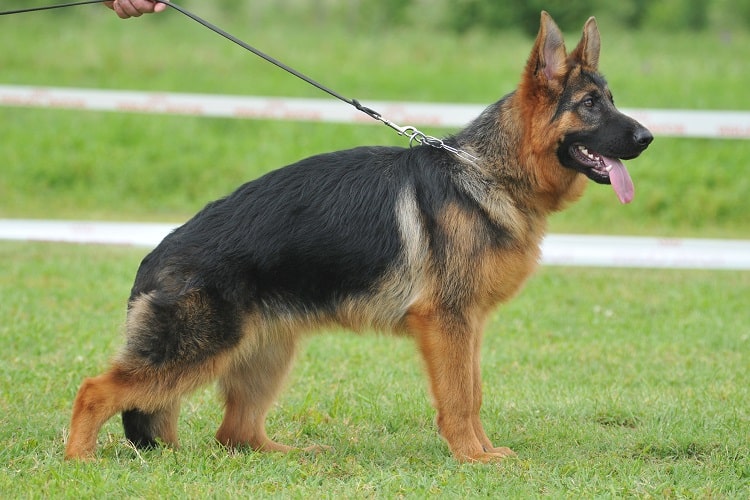
As a breed that was created to work, the German Shepherd is a smart, strong, and athletic animal. Theoretically, it’s classed as a ‘medium breed’- despite the height in the shoulder, they are lithe and lean.
However, you will see plenty of dogs today that fall in the large-breed category, thanks to the unique nature of GSD breeding.
The American Kennel Club standard for the German Shepherd is 60-90 pounds in weight for males. Females can be a little lighter, ranging from 50-75 pounds.
The show line is mainly found with the classic GSD look- a black ‘saddle blanket’ marked with a tan or red coat. Their more angulated top line is their most defining characteristic, although they tend to take that same broadness into their bodies and heads.
They typically have longer, heavier coats than their working line compatriots and may shed a bit more.
Temperament
The American Show Line German Shepherd scores much better on temperament for families than the working line. They’re less intense, far calmer, and have a more friendly nature.
This can make them less high-energy than their working line compatriots, though a low-energy GSD is rare!
They have a lower prey drive than working line Shepherds, making them ideal for homes with other pets.
While they remain an active breed, they also have less of a working drive, which tends to suit family homes better. Their strong protective instincts remain, and they will be naturally wary of strangers.
Remember that every dog has a unique personality, which won’t always match the breed standard. Low-quality breeders can also produce nervous, anxious dogs prone to snapping.
However, many American Show Line German Shepherds are playful dogs and can be goofy attention-seekers. They tend to be very affectionate, too.
A typical price for a well-bred American Show Line German Shepherd is around $800; show-quality specimens can ask a lot more.
Health
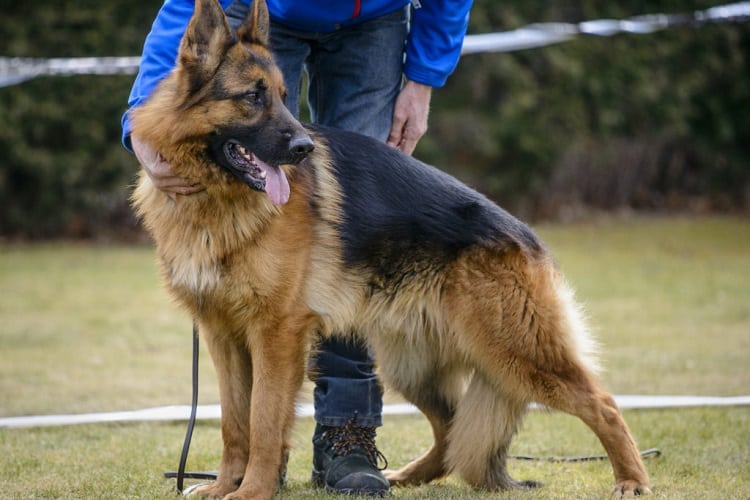
Because the show line focuses more on physical appearance than work capability alone, they can be a little more prone to health problems. Because of their shorter hind legs and angular back, this mostly centers on hip and elbow issues.
All intelligent working breeds need socialization and training to help them stay as happy and healthy as possible. Your home will need toys, puzzles, and enrichment games for your dog to thrive truly, and they do very well with a ‘job,’ even if that’s just playing, as it’s coded into their genes.
The typical lifespan for one of these dogs is 10-14 years. However, poorly bred specimens can have their life regrettably shortened by the higher prevalence of health issues in backyard breeder stock.
Remember that responsible breeders invest a lot in genetic and health screenings to give their puppies the best chance of thriving, healthy, and happy lives.
Don’t let this put you off adopting a shelter dog, however. GSDs are sadly overrepresented in shelters, and many need good, loving homes to thrive.
Expect to brush your dog regularly to help loosen its dense coat and prevent shedding issues. Shedding is heaviest as the season changes between winter and summer. They will also need the occasional bath to loosen the dead coat and keep them smelling fresh.
Dietary Needs
American Show Line German Shepherds thrive on a high-quality diet with 18-22% protein. Adults need about 5% dietary fat, with puppies needing a little more.
You may want to look at a large-breed-specific diet. These often include extra nutrients focused on joint health to help your dog lead a happy, healthy life.
All dogs are omnivores and can enjoy some dog-safe fruits and veggies in their diet, but this should only ever account for about 10% of the overall nutrition they receive.
Some owners opt for a mix of dry and wet feeding, but it is important to ensure that any off-standard diet meets their intense energy and nutrient needs to keep your dog balanced and happy.
The American Show Line German Shepherd is a large dog, so quality feeding will work wonders to keep your dog fit and thriving through all life stages.
They will need anywhere from 2.5 cups to 5 cups of food a day, depending on age, lifestyle, activity, and the food you choose, so budget accordingly.
American Show Line German Shepherds As Family Pets
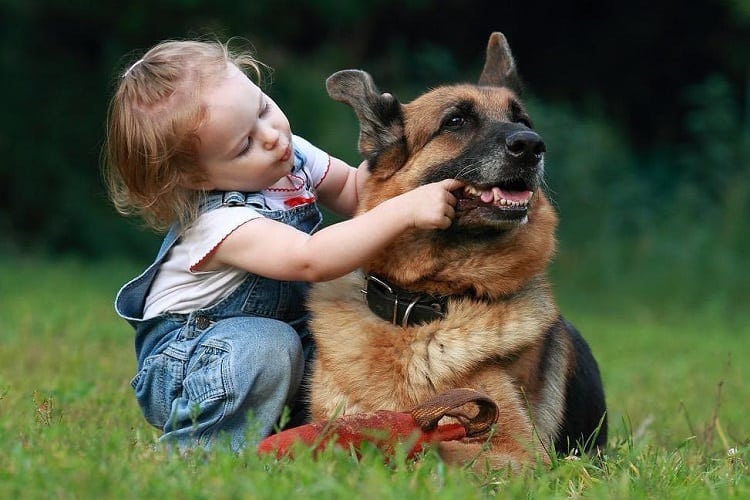
The breed’s profound intelligence makes them easy to train, but they’re definitely for a family with an active lifestyle.
They are also made to work in challenging positions alongside their people- that’s why you often see them in drug-sniffing, and explosives work, search and rescue, protection, the military, and law enforcement. Of course, they’re also popular service dogs.
The breed thrives in a home where the owners want to invest in their dog. This is the ideal buddy for training and obedience, more exotic dog sports like ‘dancing with dogs,’ fly ball, and much more.
They need their intense intelligence and restless activity productively focused for the best results.
As family pets, these are dogs you could take hiking, running, walking, or simply play with daily. The German Shepherd already has a protective nature, so it will be watchful over its family and can even do some jobs around the house!
Unlike many working line dogs, who bond with one owner, an American Show Line German Shepherd is likely to bond well with the whole family.
An American Show Line German Shepherd is a loving and loyal dog with an intelligent mind and an easily trainable persona.
They make wonderful family pets if they have the mental stimulation and exercise they need to thrive.
Remember that any dog that doesn’t have its exercise and stimulation needs met can become anxious and destructive, and American Show Line German Shepherds are no different.
How Protective Are American Show Line German Shepherds?
Protective instincts are built into this breed, regardless of the line they stem from.
However, due to the calmer and friendlier nature of the show line dogs, they actually make a better ‘protective family pet’ than the working line, which can be very intolerant and intense.
An American Show Line German Shepherd will still need mental stimulation and training to thrive, and poor socialization can lead to issues with fear-based aggression.
Socialization and training are also crucial for good manners. They can be very fulfilling to train because of their quick wits and eagerness to please.
Conclusion
The American Show Line German Shepherd is a great family pet and a GSD with a calmer temperament and gentler nature than the working line breed.
It can make a great family pet if you’re honest about how much time, activity, and attention you can give the dog. While it is slightly more prone to joint problems than the working line, the show line dogs are fantastic companions with a lot to offer.
German Shepherds are an intelligent, loyal, and dedicated breed all around. Understanding their line and heritage is a great help in ensuring your new best friend will be a perfect match for you.






























